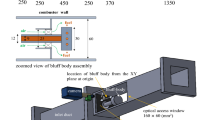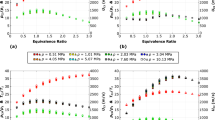Abstract
This paper presents experimental investigations in an effusion cooled single sector gas turbine combustor under close-to-reality boundary conditions, i.e. elevated pressure and combustor inlet temperature, under varying staging conditions. Flow field, flame structure and gas-phase temperature measurements are performed using particle image velocimetry (PIV), planar laser induced fluorescence of the hydroxyl radical (OH-PLIF) and coherent anti-Stokes Raman scattering (CARS), respectively. Additionally, isothermal mixing of the pilot and main stage is investigated using Acetone-PLIF. The influence of the pilot on the measured quantities can be identified up to 30 mm downstream of the burner head plate. These measurements are conducted within a novel test rig dedicated to the investigation of swirl-stabilized pressurized flames and effusion-cooling. The rig features full optical access for non-intrusive laser diagnostics from three sides and a modular effusion liner geometry. Important process parameters can be controlled independently in a wide range, providing a high versatility and reliability in terms of boundary conditions. Oxidizer and cooling air mass flows can be conditioned independently to 773 K and 973 K, respectively. Fuel staging can be gradually varied between 0% (fully premixed) and 100% (pilot only) at thermal loads up to 150 kW and a maximum pressure of 1,0 MPa. A movable block radial swirler allows for varying geometrical swirl numbers.

























Similar content being viewed by others
Notes
Detailed investigation of the interaction between cooling air and main flow is not described in this publication and will be part of a second paper.
References
Al-Abdeli, Y.M., Masri, A.R.: Review of laboratory swirl burners and experiments for model validation. Exp. Thermal Fluid Sci. 69, 178–196 (2015)
Andreini, A., Becchi, R., Facchini, B., Mazzei, L., Picchi, A., Turrini, F.: Adiabatic effectiveness and flow field measurements in a realistic effusion cooled lean burn combustor. J. Eng. Gas Turbines Power 138(3), 31506 (2016)
Behrendt, T., Hassa, C.: A test rig for investigations of gas turbine combustor cooling concepts under realistic operating conditions. Proceedings of the Institution of Mechanical Engineers, Part G: Journal of Aerospace Engineering 222(2), 169–177 (2008). https://doi.org/10.1243/09544100JAERO288
Behrendt, T., Lengyel, T., Hassa, C., Gerendás, M.: Characterization of advanced combustor cooling concepts under realistic operating conditions. In: ASME Turbo Expo 2008: Power for Land, Sea, and Air, pp. 1801–1814. https://doi.org/10.1115/GT2008-51191 (2008)
Birch, A.D., Brown, D.R., Dodson, M.G., Thomas, J.R.: The turbulent concentration field of a methane jet. J. Fluid Mech. 88(03), 431 (1978). https://doi.org/10.1017/S0022112078002190
Ewart, P.: A modeless, variable bandwidth, tunable laser. Opt. Commun. 55(2), 124–126 (1985). https://doi.org/10.1016/0030-4018(85)90314-1
Feist, J.P., Heyes, A.L., Seefelt, S.: Thermographic phosphor thermometry for film cooling studies in gas turbine combustors. Proceedings of the Institution of Mechanical Engineers, Part A: Journal of Power and Energy 217(2), 193–200 (2003). https://doi.org/10.1243/09576500360611227
Goldstein, R.J.: Film cooling. Adv. Heat Tran. 7, 321–379 (1971)
Goodwin, D.G., Moffat, H.K., Speth, R.L.: Cantera: An object-oriented software toolkit for chemical kinetics, thermodynamics, and transport processes. https://doi.org/10.5281/zenodo.170284. Version 2.1.0. http://www.cantera.org (2015)
Gritsch, M., Baldauf, S., Martiny, M., Schulz, A., Wittig, S.: The superposition approach to local heat transfer coefficients in high density ratio film cooling flows. In: ASME 1999 International Gas Turbine and Aeroengine Congress and Exhibition, p. V003t01a048. https://doi.org/10.1115/99-GT-168 (1999)
Gritsch, M., Colban, W., Schär, H., Döbbeling, K.: Effect of hole geometry on the thermal performance of fan-shaped film cooling holes. J. Turbomach. 127(4), 718 (2005). https://doi.org/10.1115/1.2019315
Haselbach, F., Newby, A., Parker, R.: Concepts & technologies for the next generation of large civil aircraft engines. In: 29th Congress of the International Council of the Aeronautical Science, St. Petersburg, Russia (2014)
Heeger, C.: Flashback investigations in a premixed swirl burner by high-speed laser imaging. 601 VDI Verlag GmbH (2012)
Heeger, C., Gordon, R., Tummers, M., Sattelmayer, T., Dreizler, A.: Experimental analysis of flashback in lean premixed swirling flames: upstream flame propagation. Exp. Fluids 49(4), 853–863 (2010)
Huang, Z., Xiong, Y.B., Liu, Y.Q., Jiang, P.X., Zhu, Y.H.: Experimental investigation of full-coverage effusion cooling through perforated flat plates. Appl. Therm. Eng. 76, 76–85 (2015)
Jackowski, T., Schulz, A., Bauer, H.J., Gerendás, M., Behrendt, T.: Effusion cooled combustor liner tiles with modern cooling concepts: a comparative experimental study. In: ASME Turbo Expo 2016: Turbomachinery Technical Conference and Exposition. American Society of Mechanical Engineers, pp. V05BT17A007–V0517A007 (2016)
Janicka, J., Kuehne, J., Kuenne, G., Ketelheun, A.: Large eddy simulation of combustion systems at gas turbine conditions. In: Flow and Combustion in Advanced Gas Turbine Combustors. Springer, pp. 183–204 (2013)
Kallas, S., Geoghegan-Quinn, M., Darecki, M., Edelstenne, C., Enders, T., Fernandez, E., Hartman, P.: Flightpath 2050 europe’s vision for aviation. Report of the high level group on aviation research, European commission, Brussels, Belgium, Report No. EUR 98 (2011)
Lange, L., Heinze, J., Schroll, M., Willert, C., Behrendt, T.: Combination of planar laser optical measurement techniques for the investigation of pre-mixed lean combustion. 16th int symp on applications of laser techniques to fluid mechanics. Lisbon, Portugal pp. 09–12 (2012)
Le Brocq, P.V., Launder, B.E., Priddin, C.H.: Discrete hole injection as a means of transpiration cooling; an experimental study. ARCHIVE: Proceedings of the Institution of Mechanical Engineers 1847-1982 (vols 1-196) 187(1973), 149–157 (1973). https://doi.org/10.1243/PIME_PROC_1973_187_095_02
Leger, B., Miron, P., Emidio, J.: Geometric and aero-thermal influences on multiholed plate temperature: Application on combustor wall. Int. J. Heat Mass Transf. 46(7), 1215–1222 (2003). https://doi.org/10.1016/S0017-9310(02)00396-4
Mann, M., Jainski, C., Euler, M., Böhm, B., Dreizler, A.: Transient flame–wall interactions: Experimental analysis using spectroscopic temperature and co concentration measurements. Combust. Flame 161(9), 2371–2386 (2014). https://doi.org/10.1016/j.combustflame.2014.02.008
Martiny, M.: Wärmeübergang in Effusionsgekühlten Flammrohrwänden: Univ., Diss.–Karlsruhe, 1998, Forschungsberichte Aus Dem Institut Für Thermische Strömungsmaschinen, vol. 6, 1. aufl. edn. Cuvillier, Göttingen (1999)
Metzger, D.E., Takeuchi, D.I., Kuenstler, P.A.: Effectiveness and heat transfer with full-coverage film cooling. Journal of Engineering for Power 95(3), 180 (1973). https://doi.org/10.1115/1.3445720
Palmer, R.: The carsft computer code calculating coherent anti-stokes raman spectra: user and programmer information. Tech. Rep., Sandia National Labs., Livermore (1989)
Perona, P., Malik, J.: Scale-space and edge detection using anisotropic diffusion. IEEE Trans. Pattern Anal. Mach. Intell. 12(7), 629–639 (1990)
Pitts, W.M.: Effects of global density ratio on the centerline mixing behavior of axisymmetric turbulent jets. Exp. Fluids 11-11(2-3), 125–134 (1991). https://doi.org/10.1007/BF00190288
Roy, S., Gord, J.R., Patnaik, A.K.: Recent advances in coherent anti-stokes raman scattering spectroscopy: Fundamental developments and applications in reacting flows. Prog. Energy Combust. Sci. 36(2), 280–306 (2010)
Schulz, A.: Combustor liner cooling technology in scope of reduced pollutant formation and rising thermal efficiencies. Ann. N. Y. Acad. Sci. 934(1), 135–146 (2001). https://doi.org/10.1111/j.1749-6632.2001.tb05848.x
Smith, G.P., Golden, D.M., Frenklach, M., Moriarty, N.W., Eiteneer, B., Goldenberg, M., Bowman, C.T., Hanson, R.K., Song, S., Gardiner Jr, W., et al.: Gri-mech 3.0. http://www.me.berkeley.edu/gri_mech (2011)
Syred, N.: A review of oscillation mechanisms and the role of the precessing vortex core (pvc) in swirl combustion systems. Prog. Energy Combust. Sci. 32(2), 93–161 (2006). https://doi.org/10.1016/j.pecs.2005.10.002
Thole, K.A., Gritsch, M., Schulz, A., Wittig, S.: Effect of a crossflow at the entrance to a film-cooling hole. J. Fluids Eng. 119(3), 533 (1997). https://doi.org/10.1115/1.2819277
Weinkauff, J., Trunk, P., Frank, J., Dunn, M., Dreizler, A., Böhm, B.: Investigation of flame propagation in a partially premixed jet by high-speed-stereo-piv and acetone-plif. Proc. Combust. Inst. 35(3), 3773–3781 (2015)
Westerweel, J.: Efficient detection of spurious vectors in particle image velocimetry data. Exp. Fluids 16-16(3-4), 236–247 (1994). https://doi.org/10.1007/BF00206543
Wieneke, B.: Stereo-piv using self-calibration on particle images. Exp. Fluids 39(2), 267–280 (2005). https://doi.org/10.1007/s00348-005-0962-z
Wieneke, B.: Piv uncertainty quantification from correlation statistics. Meas. Sci. Technol. 26(7), 74002 (2015). https://doi.org/10.1088/0957-0233/26/7/074002
Wurm, B., Schulz, A., Bauer, H.J.: A New Test Facility for Investigating the Interaction between Swirl Flow and Wall Cooling Films in Combustors. In: ASME Turbo Expo 2009: Power for Land, Sea, and Air, pp. 1397–1408. https://doi.org/10.1115/GT2009-59961 (2009)
Acknowledgements
Funding by Deutsche Forschungsgemeinschaft through project DR374/12-1 is greatly acknowledged.
Funding
This study was funded by Deutsche Forschungsgemeinschaft through project DR374/12-1.
Author information
Authors and Affiliations
Corresponding author
Ethics declarations
Conflict of interests
The authors declare that they have no conflict of interest.
Additional information
Publisher’s Note
Springer Nature remains neutral with regard to jurisdictional claims in published maps and institutional affiliations.
Rights and permissions
About this article
Cite this article
Hermann, J., Greifenstein, M., Boehm, B. et al. Experimental Investigation of Global Combustion Characteristics in an Effusion Cooled Single Sector Model Gas Turbine Combustor. Flow Turbulence Combust 102, 1025–1052 (2019). https://doi.org/10.1007/s10494-018-9999-y
Received:
Accepted:
Published:
Issue Date:
DOI: https://doi.org/10.1007/s10494-018-9999-y




